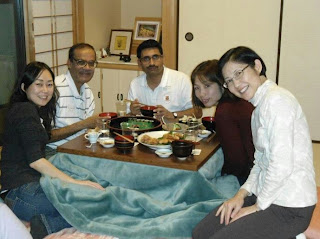Feedback is the
vital component that completes any communication cycle. In case of this exchange
programme with Waseda University we, the students of Chowgule college were entrusted
an important responsibility of communicating the culture of India and learning
the different aspects of Japanese society and culture. After a two week long interaction with Waseda students,
faculty and staff we received feedback in various forms and at various points
in time.
Students were willing
to know more about India, its society and culture, our educational system and
institution (Chowgule college). We found
that places like New Delhi, Jaipur etc were quite famous among those who had
previously visited India or whose relatives worked in India.
Faculty tried to
make regular sessions interactive and easy to understand by comparing
situations in India and Japan especially evident from lectures of Prof. Watt on
Religion (Shinto, one of the major religions in Japan, other being Buddhism)
and Prof. Iino on Socio-linguistics. Students and faculty in Socio-linguistics
class were amazed to know that India had many languages and each of us could
speak not less than 3-5 languages. Faculty welcomed our questions and opinions
during and after the sessions.
Supporting staff
too was very co-operative and gave necessary inputs and information before
sessions and field trips like maps, excerpts on ceremonies and etiquettes etc.
| With Takako san at Sensoji Temple |
| With Yuri san at Sensoji Temple |
Everyone
appreciated our performances at Indian Cultural Night on 12th
November. One of the most memorable feedbacks was from Ms. Keiko Iizuka, an
English teacher and Koto (Japanese traditional Harp) player, who was literally in
tears and had no words to express the joy she felt after listening to my Indian
classical recital. I regard her appreciation to be an evidence to prove that
music and culture irrespective of language barriers have the capability of
touching one’s soul and giving immense happiness to all. Prof. Gally expressed
his appreciation through small videos that he shot of the event.
Discussion on
Japanese society and culture with Mr. Yamaguchi during the trip to Kamakura and
interaction with Prof. Sadoshima while visiting the Shinnyo-en temple are the
two experiences I would cherish for lifetime.
The post would
be incomplete without mentioning the feedback I received after returning to
India in form of an email from Prof. Sadoshima in which she says :
“I am also very happy to hear that your trip to Japan
was a fruitful one. I very much enjoyed the songs, recitation, and the dance
you performed at the Indian Cultural Night. They were beautiful and profound.
Your visit to Kamakura and Shinnyo-en Temple meant a lot to me, too. Your keen
eyes and rich understanding of history, culture, and language is astonishing.”
Note : A glimpse
of Indian Cultural night can be sought at the following link through a small
video shot by Prof. Gally






